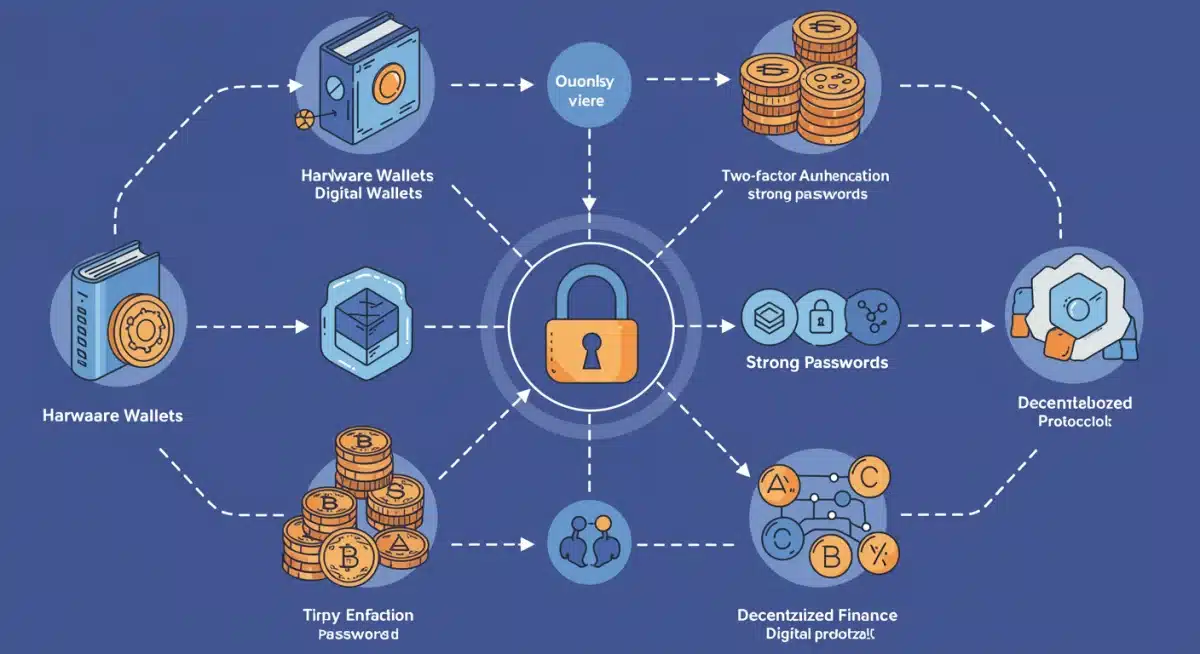Digital Asset Security: U.S. Investor Steps Before March 2025

Latest developments on Maximizing Digital Asset Security: Essential Steps for U.S. Investors Before March 2025 (TIME-SENSITIVE) with key facts, verified sources, and what readers need to monitor next in Estados Unidos, presented clearly in Inglês (Estados Unidos) (en-US).
Maximizing Digital Asset Security: Essential Steps for U.S. Investors Before March 2025 (TIME-SENSITIVE) is shaping today’s agenda with new details emerging from officials and industry sources. This update prioritizes what changed, why it matters, and what to watch next, in a clear news format.
Understanding the March 2025 Deadline and its Implications
The approaching March 2025 deadline is not an arbitrary date; it signifies a critical juncture for digital asset holders in the U.S. This period anticipates heightened regulatory clarity, increased enforcement, and potentially new compliance standards that will profoundly impact how digital assets are stored, managed, and reported. Investors must grasp the full scope of these impending changes to fortify their positions proactively.
Regulatory bodies, including the SEC and FinCEN, are actively developing frameworks to address the complexities of the digital asset landscape. These frameworks aim to mitigate risks such as illicit finance, market manipulation, and consumer fraud. For investors, this translates to a need for robust security measures, not just against external threats but also in adherence to evolving legal requirements. Ignoring this timeline could lead to significant financial vulnerabilities and compliance issues.
Regulatory Landscape Evolution
- SEC Scrutiny: The Securities and Exchange Commission continues to classify many digital assets as securities, leading to increased oversight and potential enforcement actions against non-compliant entities or individuals.
- FinCEN Directives: The Financial Crimes Enforcement Network is intensifying efforts to prevent money laundering and terrorist financing through digital assets, requiring stricter reporting and identity verification protocols.
- State-Level Initiatives: Beyond federal mandates, several U.S. states are introducing their own digital asset regulations, creating a complex web of compliance requirements for investors operating across jurisdictions.
The convergence of these regulatory pressures by March 2025 underscores the urgency for investors to review and upgrade their digital asset security strategies. Being prepared means understanding both the technological safeguards and the legal obligations that will soon become standard.
Fortifying Your Digital Wallets: Hardware and Software Solutions
Securing your digital assets begins with robust wallet management. The choice between hardware and software wallets, or a combination of both, significantly impacts your security posture. As the March 2025 deadline approaches, reassessing and upgrading these foundational elements is non-negotiable for U.S. investors.
Hardware wallets offer the highest level of offline security, isolating your private keys from internet-connected devices, thus protecting against online threats. Software wallets, while more convenient for frequent transactions, require meticulous attention to security practices. A layered approach, utilizing hardware wallets for long-term storage and software wallets for active trading, is often recommended.
Implementing Advanced Security Protocols
- Hardware Wallet Adoption: For substantial holdings, invest in reputable hardware wallets like Ledger or Trezor. Ensure they are purchased directly from the manufacturer to avoid tampering.
- Multi-Signature Wallets: Consider multi-signature (multisig) wallets, which require multiple private keys to authorize a transaction, adding an extra layer of defense against single points of failure.
- Regular Software Updates: Keep all software wallets, exchange apps, and operating systems updated to patch vulnerabilities. Outdated software is a common entry point for cyber attackers.
The integrity of your digital wallet directly correlates with the safety of your investments. Proactive measures in this area are fundamental to effective digital asset security, especially with the evolving threat landscape and regulatory environment.
Mastering Authentication and Access Control
Beyond wallet choices, the methods you use to authenticate and control access to your digital asset accounts are paramount. Weak authentication is a leading cause of security breaches. As the March 2025 deadline looms, U.S. investors must elevate their authentication protocols to meet new industry standards and protect against increasingly sophisticated cyberattacks.
Two-Factor Authentication (2FA) and Multi-Factor Authentication (MFA) are no longer optional but essential safeguards. Implementing strong, unique passwords for every platform and utilizing password managers further strengthens your defenses. The goal is to create multiple barriers that even a determined attacker would find difficult to penetrate.

Enhancing Your Authentication Strategy
- Hardware 2FA (e.g., YubiKey): Opt for hardware-based 2FA over SMS or authenticator apps where possible, as it is less susceptible to phishing and SIM-swapping attacks.
- Strong, Unique Passwords: Generate complex, unique passwords for each digital asset platform and exchange. Never reuse passwords across different services.
- Password Manager Utilization: Employ a reputable password manager to securely store and generate strong credentials, reducing the risk of human error and credential compromise.
Effective access control is a continuous process that requires vigilance. By implementing and regularly reviewing these authentication practices, investors can significantly enhance their digital asset security and mitigate the risk of unauthorized access.
Understanding and Mitigating Phishing and Social Engineering Threats
Cybercriminals are constantly evolving their tactics, with phishing and social engineering remaining among the most effective methods for compromising digital assets. U.S. investors, particularly as the March 2025 deadline approaches, must develop a keen awareness of these threats and implement strategies to protect themselves from manipulation and deception.
Phishing attacks typically involve deceptive communications designed to trick individuals into revealing sensitive information, such as private keys or login credentials. Social engineering exploits human psychology to gain unauthorized access. Recognizing the red flags of these attacks is crucial, as even the most sophisticated technological defenses can be bypassed if an individual is tricked into compromising their own security.
Common Attack Vectors and Prevention
- Email and SMS Phishing: Be wary of unsolicited emails or messages asking for personal information, promising unrealistic returns, or threatening account closure. Always verify sender identity and links before clicking.
- Impersonation Scams: Attackers often impersonate legitimate entities (exchanges, wallet providers, regulatory bodies) to gain trust. Always contact official support channels directly for verification.
- Malicious Software (Malware): Be cautious of downloading software from untrusted sources. Malware can log keystrokes, steal credentials, or gain remote access to your device, compromising your digital asset security.
A proactive and skeptical mindset is your best defense against these insidious threats. Continuous education on the latest scam techniques is vital for protecting your digital assets in an ever-changing threat landscape.
The Role of Decentralized Finance (DeFi) in Security Planning
Decentralized Finance (DeFi) offers innovative opportunities but also introduces unique security considerations for U.S. investors. As the digital asset ecosystem matures towards March 2025, understanding DeFi’s security implications is critical. While DeFi aims to remove intermediaries, it shifts the responsibility of security entirely to the user, demanding a high level of technical understanding and caution.
Smart contract vulnerabilities, rug pulls, and flash loan attacks are prevalent risks within the DeFi space. Investors engaging in DeFi protocols must exercise extreme diligence, performing thorough due diligence on projects, understanding the underlying code, and utilizing tools that enhance security within these environments. The promise of high returns often comes with commensurately high risks if security is not prioritized.

Navigating DeFi Security Challenges
- Smart Contract Audits: Only interact with DeFi protocols that have undergone rigorous, independent smart contract audits by reputable firms. Review audit reports for identified vulnerabilities.
- Understanding Impermanent Loss: For liquidity providers, comprehend the risks of impermanent loss in automated market makers (AMMs), which can erode capital even in rising markets.
- Wallet Permissions and Revocation: Regularly review and revoke unnecessary wallet permissions granted to DeFi protocols, as these can be exploited if a protocol is compromised.
Integrating DeFi into your investment strategy requires a sophisticated understanding of its unique security challenges. Prioritizing robust digital asset security practices within this innovative sector is essential for protecting your capital.
Preparing for Future Regulations and Compliance
The period leading up to and beyond March 2025 will likely see significant shifts in the regulatory landscape for digital assets in the U.S. For investors, this means not only adapting current security practices but also anticipating future compliance requirements. Proactive engagement with regulatory updates and professional guidance will be key to maintaining a secure and legally compliant investment portfolio.
New reporting obligations, changes in tax treatment, and stricter KYC/AML (Know Your Customer/Anti-Money Laundering) mandates are all potential outcomes. Investors should begin consolidating their transaction records, understanding their tax liabilities, and seeking legal or financial advice to ensure they are well-positioned for any new directives. Ignorance of the law is no defense, especially in an area under intense governmental scrutiny.
Key Areas for Regulatory Preparedness
- Record Keeping: Maintain meticulous records of all digital asset transactions, including purchase dates, prices, wallet addresses, and capital gains/losses, for tax and auditing purposes.
- Tax Implications: Consult with tax professionals specializing in digital assets to understand current and projected tax obligations. The IRS continues to clarify guidelines, and staying informed is crucial.
- Legal Consultations: Consider consulting with legal experts familiar with digital asset law to understand potential compliance risks and ensure your investment activities align with evolving regulations.
By actively preparing for future regulatory changes, U.S. investors can safeguard not only their assets from cyber threats but also from unforeseen legal or financial penalties, ensuring long-term digital asset security.
Key Action |
Brief Description |
|---|---|
Upgrade Wallets |
Shift to hardware wallets for cold storage; update software wallets regularly. |
Strengthen Authentication |
Implement hardware 2FA, unique strong passwords, and password managers. |
Combat Phishing |
Learn to identify and avoid social engineering and malicious software. |
Prepare for Regulations |
Maintain meticulous records and seek professional advice on tax and legal compliance. |
Frequently Asked Questions About Digital Asset Security
March 2025 is anticipated to bring significant regulatory clarity and enforcement actions from U.S. authorities like the SEC and FinCEN. This period will likely introduce new compliance standards and heightened scrutiny, making robust digital asset security and adherence to evolving legal requirements crucial for investors.
Hardware wallets (cold storage) are generally considered the most secure for significant holdings, as they keep private keys offline. For active trading, a combination with secure software wallets is often recommended. Always purchase hardware wallets directly from verified manufacturers to ensure authenticity and prevent tampering.
Investors should be highly skeptical of unsolicited communications, verify sender identities, and avoid clicking suspicious links. Employing strong, unique passwords, hardware-based 2FA, and reputable password managers significantly reduces vulnerability. Continuous education on new scam tactics is also vital for proactive defense.
DeFi offers opportunities but shifts full security responsibility to the user, introducing risks like smart contract vulnerabilities and rug pulls. Investors engaging in DeFi must perform thorough due diligence, review smart contract audits, and regularly revoke unnecessary wallet permissions to mitigate these specialized risks effectively.
Proactive preparation includes maintaining meticulous records of all transactions for tax and auditing purposes. Consulting with tax and legal professionals specializing in digital assets is also advisable to understand and comply with evolving reporting obligations and tax treatments, ensuring long-term financial and legal compliance.
What this means
The impending March 2025 period signals a definitive shift towards a more regulated and secure digital asset ecosystem in the U.S. Investors who prioritize proactive security upgrades and stay informed on regulatory developments will be best positioned to navigate these changes successfully. This moment demands vigilance, adaptation, and a commitment to robust security practices to safeguard investments against both cyber threats and evolving compliance mandates, ensuring sustained participation in the digital economy.





